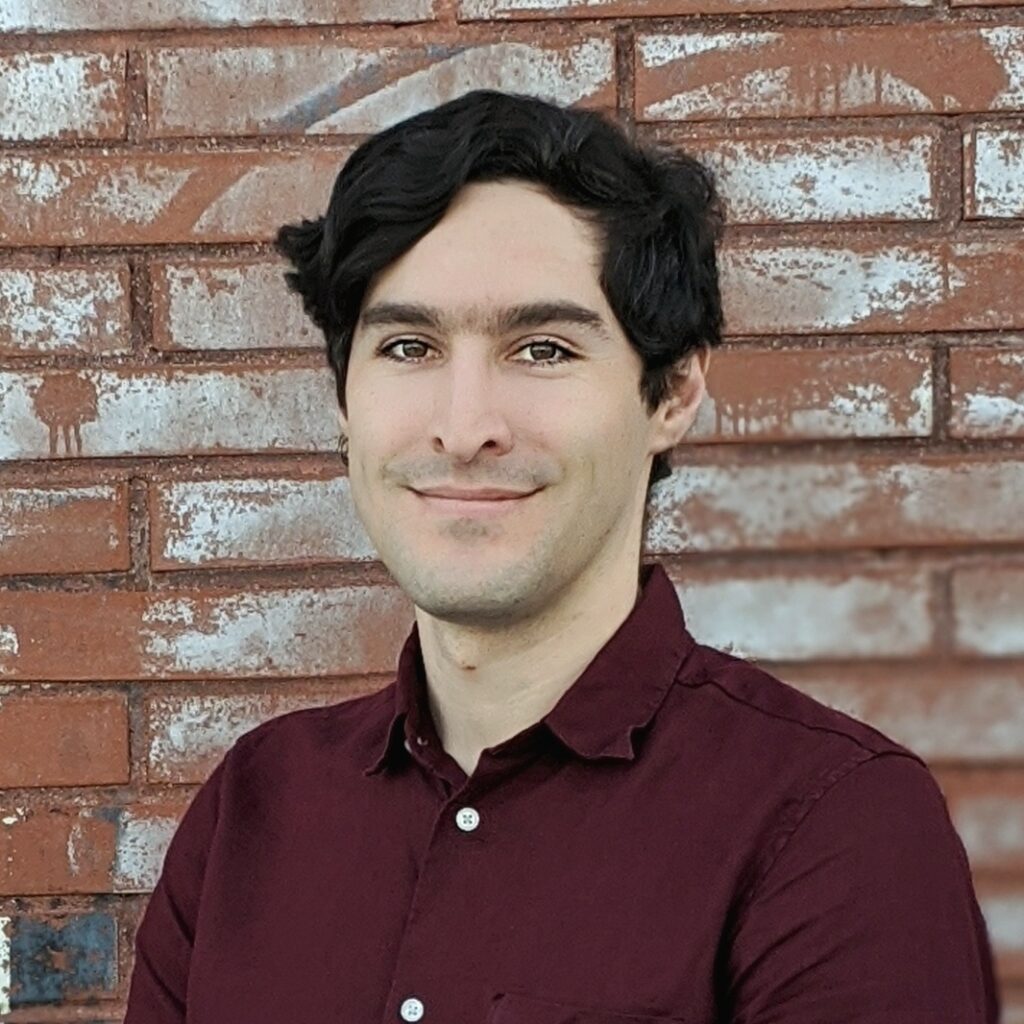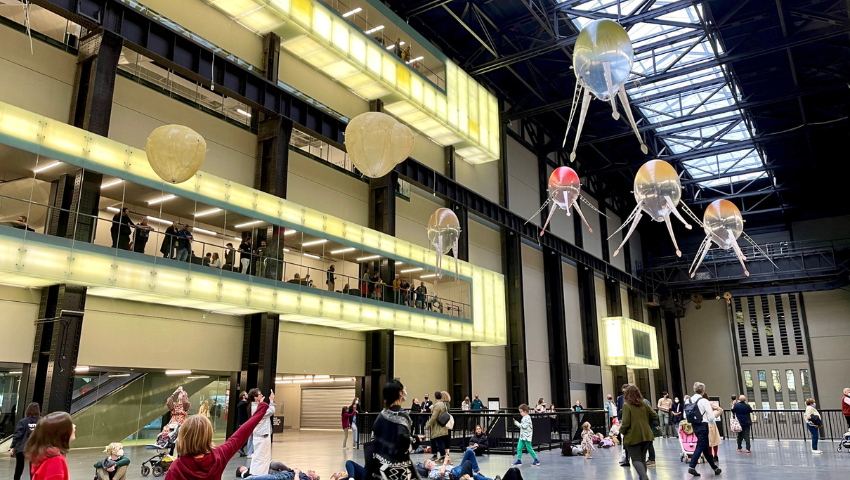This image shows the artwork installed at the Tate Modern. Visitors are allowed to wander the space with no barriers between them and the flying machines, called “Aerobes” in the context of this artwork.
It’s a bird. It’s a plane. No, it’s an Aerobe! When you look up to the ceiling in the Tate Modern, you’ll see something different than just lights. You’ll see a floating “Aquarium of Machines.” This artwork was so fascinating to Nathan Lachenmyer and Sadiya Akasha that it inspired their SIGGRAPH 2022 Art Paper, “An Aquarium of Machines: A Physically Realized Artificial Life Simulation.” To learn more about their paper, SIGGRAPH caught up with the two creators to dive into the inspiration behind choosing this artwork and an upcoming project you should be on the lookout for.
SIGGRAPH: Walk us through the process of creating your paper, “An Aquarium of Machines: A Physically Realized Artificial Life Simulation.” What inspired this paper?
Nathan Lachenmyer and Sadiya Akasha (NL and SA): This paper was inspired by our work with Anicka Yi on the Tate Modern’s Hyundai Commission last year. For this project, Yi wanted Tate Modern visitors to consider our conception of intelligence. As the rapid development of artificial intelligence (AI) continues, she asked visitors to consider why intelligence is often exclusively linked to the human brain and what other forms of intelligence could be embodied in our future. She imagined machines evolving to become living creatures and wanted to create an installation that allowed visitors to experience what this speculative future could be like. She approached Sitara Systems to help her with conceiving what these life-like machines could feel like, as well as helping with the technical development of implementing an embodied artificial intelligence that could live independently for the four-month run of the Hyundai Commission.
SIGGRAPH: Talk about the experience of having this work displayed at the Tate Modern. How did the space inspire and influence the project?
NL and SA: The space influenced us first by its vast size. The Turbine Hall is unlike almost any other space in the world in the sheer scale of it. We wanted to create something that could use the full breadth of the space, including the vertical height of it — many previous commissions had used the horizontality of the space, but we wanted to make sure to use the height as well.
Conceptually, the Turbine Hall has an interconnected history with machines. The building that is now the Tate Modern was originally a power station, and the hall once held the steam turbines that powered London. There’s an interesting history where this particular space has been, historically, a point for connecting humans and machines for decades, and this project seemed like a great opportunity to highlight that as well.
SIGGRAPH: Talk about the creation of an artificial life simulation. What was the reason behind using artificial intelligence in your project?
NL and SA: From conception, Anicka’s idea was to connect these ideas of human and machine intelligence into the space of the Turbine Hall by putting living entities into the space. As a technical partner, we were tasked with how we can create this speculative future in a way that feels real enough, that visitors could suspend disbelief. How could we get visitors to forget, even momentarily, that these were machines made from industrial materials and instead believe that they were real living creatures? That was a big challenge for us to think through, and it all came down to behavior. Regardless of the machines’ form, if they didn’t act in a way that was believably intelligent and autonomous, then visitors were bound to think of them as automatons.
That’s where this idea of artificial life came into play. There’s a rich history of researchers using research in ethology, neurology, and psychology to create realistic models for autonomous problem-solving. These models were originally created for robotic navigation and goal-driven behavior but eventually translated to computer animation, where the focus was more on appearance rather than problem-solving. That research was extremely relevant for us. What we’re doing is animating these living sculptures, rather than truly trying to create effective problem-solvers.
SIGGRAPH in particular has a long history of publishing papers in this field since at least the late 1980s, so it felt only natural for us to build on these existing ideas and then publish our own contributions and applications at SIGGRAPH.
SIGGRAPH: What was it like having the visitors wander the space with no barriers between them and the “Aerobes,” flying machines? What did the visitors experience when interacting with this installation?
NL and SA: It was about as immersive as you can get! The Aerobes are quite large — nearly 2 meters in diameter, with the larger Xenojellies being nearly 3 meters tall — and having no barriers really makes them feel awe-inspiring. Visitors’ first impression is always just being in awe of the sheer size and scope of it all; there are 12 of these creatures in the space, and they’re hovering in the air. People just can’t believe it.
But as they settle into the space, the experience often becomes more calm and meditative. Visitors love sitting amongst the Aerobes, following their favorite one around the hall, and even trying to get one to interact with them. There’s a sense of mystery, because each Aerobe is clearly intelligent to visitors, but they can’t decipher what it is that they’re doing. That balance is key — the visitors and the Aerobes are equally curious about each other.
SIGGRAPH: Do you have any upcoming projects in the works?
NL and SA: A lot of the themes present in this work have influenced our upcoming work. On one hand, we’ve become keenly interested in how we can use speculative futures to create space for conversations about important contemporary issues, the way that this project created a space to consider the future role of artificial intelligence. Along these lines, we’re interested in what other topics can be made easier to talk about by contextualizing them as speculative futures rather than political debate. Climate change and colonialism are two topics that we’ve been exploring future work in.
Another theme that’s become relevant to us is finding new ways to use technology to connect with nature. This project provided visitors an amazing opportunity to connect with alternative intelligences within a manmade environment; we’re currently interested in how to use virtual and augmented reality techniques to create other opportunities to connect more deeply with the natural world.
SIGGRAPH: What advice do you have for someone looking to submit to Art Papers for a future SIGGRAPH conference?
NL and SA: The Art Papers program is a really unique venue for presenting works in a setting that focuses not just on the technical aspects of the work but the artistic and creative ones as well. It’s a great opportunity to share not just your technical references and inspirations, but also write about your creative and artistic inspirations for your work, as well as any critical responses to it! Embrace the program as being a part of its own track, and be sure to focus on the art!
Quick! You’re running out of time to watch hours of SIGGRAPH 2022 on-demand content. Register before access closes on 31 October.

Nathan Lachenmyer is an MIT-trained, human-computer interaction researcher whose work investigates the changing relationship between humans and emerging technologies and how technology can be used as a tool to communicate and inspire people. He is a partner at Sitara Systems, a technology and design laboratory that works with artists, museums, and brands to communicate their messaging and expertise to the public through interactive experiences.

Sadiya Akasha is a product developer and a UX researcher with a background in social psychology and group dynamics. She has leveraged her skills to transform organizational thinking in marketing, investments, genetic research, data analytics, molecular diagnostics, and community-serving nonprofit arts organizations. Today, she works closely with artists and cultural institutions to help them refine and communicate their vision at the intersection of art, technology, and human-centered design.



